La Vuelta 2022 route and stages – Schedule, key dates and predictions in battle for red jersey
It’s not cool like the Giro d’Italia, or popular like the Tour de France.
What La Vuelta is, though, is way more fun than either. It might not be the Grand Tour you tell your colleagues you went to when they ask on Monday what you did at the weekend, but it’s the one you’ll be remembering fondly in years to come, and sharing stories about with pals in your nursing home.
It’s the Last Dance Grand Tour. The “One More Song” Grand Tour. The No Regrets Grand Tour.
Vuelta a España
Roglic’s to lose? The red jersey contenders out to surprise the Slovenian at La Vuelta
21 HOURS AGO
And this year it has the additional spice of being the Relegation Dogfight Grand Tour.
Three big teams currently find themselves staring into the abyss.
Thomas De Gendt may have to successfully break away 19 times to rescue Lotto Soudal from the drop zone. If Chris Froome can actually find something close to the form of his former self, then Israel-Premier Tech may yet resurrect their WorldTour hopes.
Movistar will be going all out as well. Realistically their roster arrives in Utrecht with little hope of winning the thing but, given the points on offer for high overall placings, this could be the year when a trident of potential top tenners might be an asset rather than a liability.
‘Unbelievable, crazy!’ – Roglic on winning third Vuelta
This is the race riders and teams come to with hopes (more than expectations) of salvaging something from their season. It’s why the race looks and feels the way that it does. Sadistic in places, utterly joyful and bonkers in others.
There’s nothing normal or predictable about the Vuelta. While the Tour will either journey in a clockwise loop or an anticlockwise one, and the Giro will typically travel from south to north, the Vuelta is all over the place. This edition starts in the Netherlands, two years after it was originally supposed to, and then finishes in Madrid, but if you think you know where it goes in between, well, you’re wrong.
The riders will be barely the wiser. Javier Guillen is the master of discovery and the race director has again served up several stages that venture into unknown territory, containing climbs up which no race has gone before.
For once the “flat” stages actually do look suitable for sprinters, which is why a fair few of them will be taking the start. What’s more telling from the teamsheets, however, is how many rouleurs will be in attendance.
If you think the Tour was big on breakaways… well, you ain’t seen nothing yet.
LA VUELTA 2022 ROUTE MAP
LA VUELTA 2022 – THE ROUTE
Bold = key stage, explained in detail below
| Stage 1: Fri Aug 19 | Utrecht – Utrecht | 23.2km (TTT) |
| Stage 2: Sat Aug 20 | ‘s-Hertogenbosch – Utrecht | 175.1km (Flat) |
| Stage 3: Sun Aug 21 | Breda – Breda | 193.5km (Flat) |
| Rest day: Mon Aug 22 | ||
| Stage 4: Tue Aug 23 | Votoria-Gasteiz – Laguardia | 152.5km (Medium mountains) |
| Stage 5: Wed Aug 24 | Irun – Bilbao | 187.2km (Medium mountains) |
| Stage 6: Thu Aug 25 | Bilbao – Pico Jano (San Miguel de Aguayo) | 181.2km (Summit finish) |
| Stage 7: Fri Aug 26 | Camargo – Cistierna | 190km (Medium mountains) |
| Stage 8: Sat Aug 27 | La Pola Llaviana – Collau Fancuaya | 153.4km (Summit finish) |
| Stage 9: Sun Aug 28 | Villaviciosa – Les Praeres | 171.4km (Summit finish) |
| Rest day: Mon Aug 29 | ||
| Stage 10: Tue Aug 30 | Elche – Alicante | 30.9km (ITT) |
| Stage 11: Wed Aug 31 | ElPozo Alimentacion – Cabo de Gata | 191.2km (Flat) |
| Stage 12: Thu Sep 1 | Salobrena – Penas Blancas | 192.7km (Summit finish) |
| Stage 13: Fri Sep 2 | Ronda – Montilla | 168.4km (Flat-ish) |
| Stage 14: Sat Sep 3 | Montoro – Sierra de La Pandera | 160.3km (Summit finish) |
| Stage 15: Sun Sep 4 | Martos – Alto Hoya de la Mora, Sierra Nevada | 149.6km (Summit finish) |
| Rest day: Mon Sep 5 | ||
| Stage 16: Tue Sep 6 | Sanlucar de Barrameda – Tomares | 189.4km (Flat) |
| Stage 17: Wed Sep 7 | Aracena – Monasterio de Tentudia | 162.3km (Uphill finish) |
| Stage 18: Thu Sep 8 | Trujillo – Alto del Piornal | 192km (Summit finish) |
| Stage 19: Fri Sep 9 | Talavera de la Reina – Talavera de la Reina | 138.3km (Medium mountains) |
| Stage 20: Sat Sep 10 | Moralzarzal – Puerto de Navacerrada | 181km (Mountains) |
| Stage 21: Sun Sep 11 | Las Rozas – Madrid | 96.7km (Flat) |
LA VUELTA 2022 – KEY STAGES
Stage 1, August 19: Utrecht – Utrecht (23.2km, TTT)

A team time trial, in this economy? Now realistically, a 25 minute TTT is not likely to wildly influence who is standing atop the podium in Madrid, three weeks hence. Not one where everyone stays upright, at any rate.
Given that it’s been three long years since we were last treated to a WorldTour race against the clock in this format, however, there is no guarantee of that.
On that occasion, you may recall, Jumbo Visma took a tumble on the shores of Las Salinas de Torrevieja, after someone left a hose out. As a result they finished 18th out of 22 teams, and left leader Primoz Roglic with 40 seconds to make up on Miguel Angel Lopez. Spoiler: he managed it, and then some.
Anyway, it should be fun. Ragged as anything, as none of the riders will have had much chance to practise, let alone in their line-ups, but fun. It really is anyone’s guess how it’ll go, but the big teams do tend to go better in these events, so let’s say Jumbo Visma, Ineos Grenadiers, QuickStep Alpha Vinyl, in any order you like.
Stage 6, August 25: Bilbao – Ascension al Pico Jano. San Miguel de Aguayo (181.2 km, mountains)

With some justification, La Vuelta doesn’t consider the classification “hilly” to be a label that does justice to its nose-bleedingly steep slopes. Instead the organisers opt to describe stages as either “medium mountain” or “mountain.” Stage 6 is the first of the latter, but it follows two attritional days of the former.
That, along with the first summit finish of the race, is what will make this one hurt.
The average gradient of the Pico Jano, making its Vuelta debut, is listed as a barely botherable 6.55%. What that fails to account for, however, is almost two kilometres of false flat in the middle. Mean in more ways than one.
It will be easy for riders to overdo it in the first half of the climb and have little left for the second. Once they’re past the reservoir and onto a stretch of recently resurfaced trail, the climb is much more open. The warm Cantabrian winds could come into play, even as the road rears up.
Stage 8, August 27, La Pola Llaviana/Pola de Laviana – Collau Fancuaya. Yernes y Tameza (153.4 km, mountains)
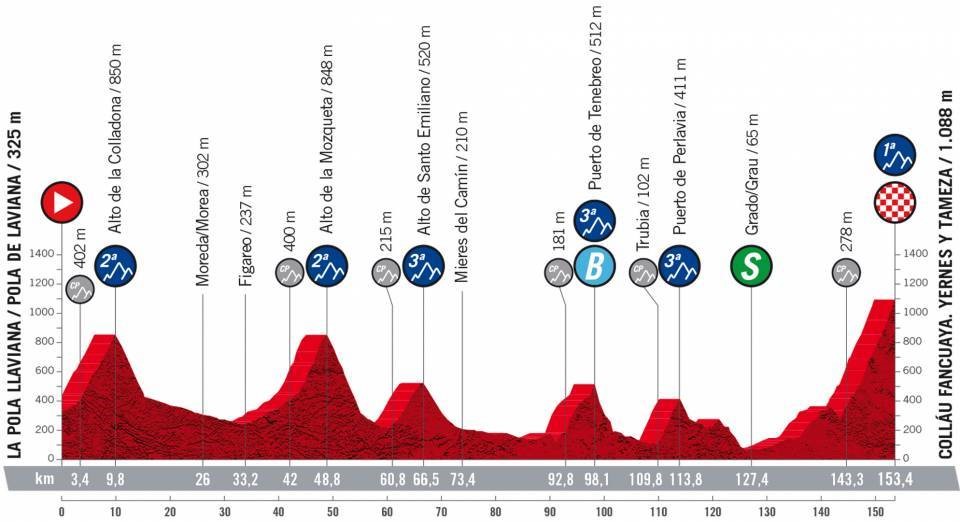
There are those who insist that summit finishes are overrated. They will argue that a stage with a long steep climb at the end only serves to stifle all of the racing in the run-up. It’s all too predictable, they will tell you.
They may have a point, particularly when it comes to a parcours presenting one headline hill like an Alpe d’Huez or a Ventoux (or Lagos de Covadonga or an Angliru.)
Which is why this stage may be exceptional.
It’s less than 100 miles from the Pola de Laviana start to the Collau Fancuaya finish but the course still manages to pack in 3300m of climbing across five moderate mountains and one murderous one. Described by dangerousroads.org, of all websites, as “inhumane” the Fancuaya is another climb we will be encountering for the first time. It will only be made more unpleasant by the preceding quintet of ascents which will reduce the riders chances of arriving at the foot of it in decent shape to near zero.
We can expect a bloody and bruising battle between the survivors, and a likely change of race lead on the penultimate day in Asturias.
Stage 10, August 30: Elche – Alicante (30.9 km, ITT)
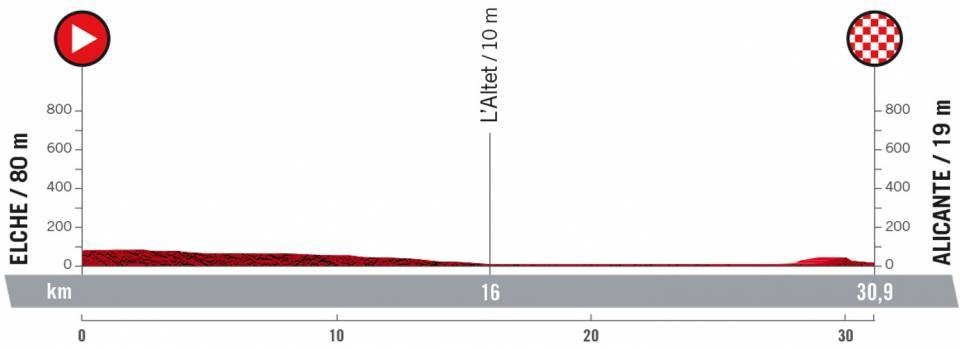
La Vuelta feels like it comes to Alicante all the time, but its visits are in fact a lot less frequent than you might imagine. On a mere six occasions has the tourist trap welcomed a finish. More often it will pass by, and occasionally through, but not stop (or start) in the city.
And as familiar as it will feel to viewers, it’s also never hosted a time trial.
Starting the second week with a race against the clock is an act of cruelty towards the contenders, a kindness for their domestiques. The brutes who would otherwise find themselves glued to the front of the race, keeping the breakaway on a short leash, or their leaders out of harm’s way, will instead simply have to get round within the (roughly 45-minute) time limit.
There’ll be no such luxury for the wearer of the rojo skinsuit, unfortunately. He will be pushing himself to the limit across every one of the 30 kilometres. Depending on who he is, the goal will either be to keep a lid on his losses – and make up for them in the next set of mountains – or augment his advantage so he can play defence later in the week. This stage, with its northbound run along the Levante coastline, will be no day at the beach.
Stage 14, September 3: Montoro – Sierra de La Pandera (160.3 km, mountains)
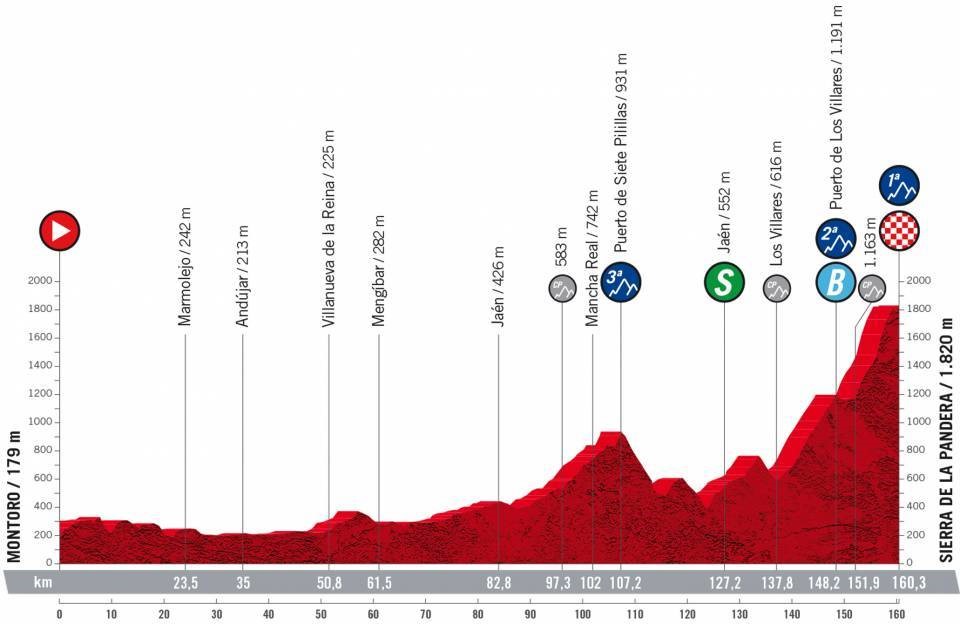
Another summit finish? Well you might raise an eyebrow or two, but we get what we’re given. Truth be told, if you’ve ever found yourself trying to negotiate a narrow Spanish farm track in the height of summer, you can understand why it would be inadvisable to force some of the best riders in the world to race down them.
La Pandera is a Vuelta staple, though it’s been nearly nineteen years since a Spaniard won here. That same rider will be hoping to put in another performance on the “Angliru of the South”, though whether Alejandro Valverde can repeat himself will likely be less up to him and more the better placed GC riders.
Who among them can come up with something special may have more to do with their bodies’ abilities to manage the heat. Andalucia is due to experience temperatures of close to 40 degrees celsius this week and while it might be cooler up high – this stage nudges the 2000m elevation – the ice packs are sure to be in high demand.
Stage 15, September 4: Martos – Sierra Nevada. Alto Hoya de la Mora. Monachil (152.6 km, mountains)
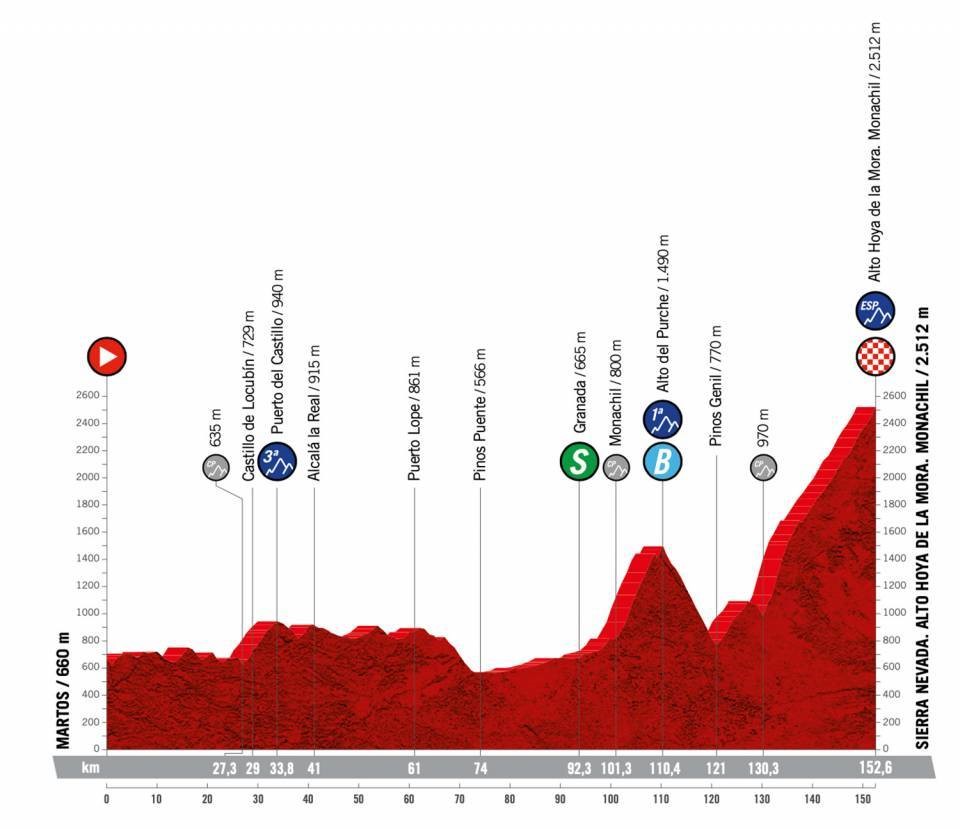
This is the stage for riders with… altitude. It will be the only time this year’s Vuelta will take them over 2000m, but once it does, it keeps going. And going. And going.
2512m is the official height of the finish line, which they will reach after 19 brutal km of the Alto Hoya de la Mora, the only special category climb in the race, which lifts them a massive 1600m in one long swoop. It’s not completely unrelenting, however, thanks to a couple of kilometres in the low single digits towards the top. The hardest of the slopes are to be found lower down the mountain, which ought to allow the rest of it to be raced, rather than merely endured and overcome.
Though many of those on the startline will know the finish up to Sierra Nevada like the back of their hands, that will mainly have been from training camps. It’s been five years since La Vuelta last concluded a competitive race here, with Colombian Miguel Angel Lopez putting everyone to the sword on that occasion.
Could another South American, Richard Carpaz, prove the executioner this time around?
Stage 20, September 10: Moralzarzal – Puerto de Navacerrada (181 km, mountains)
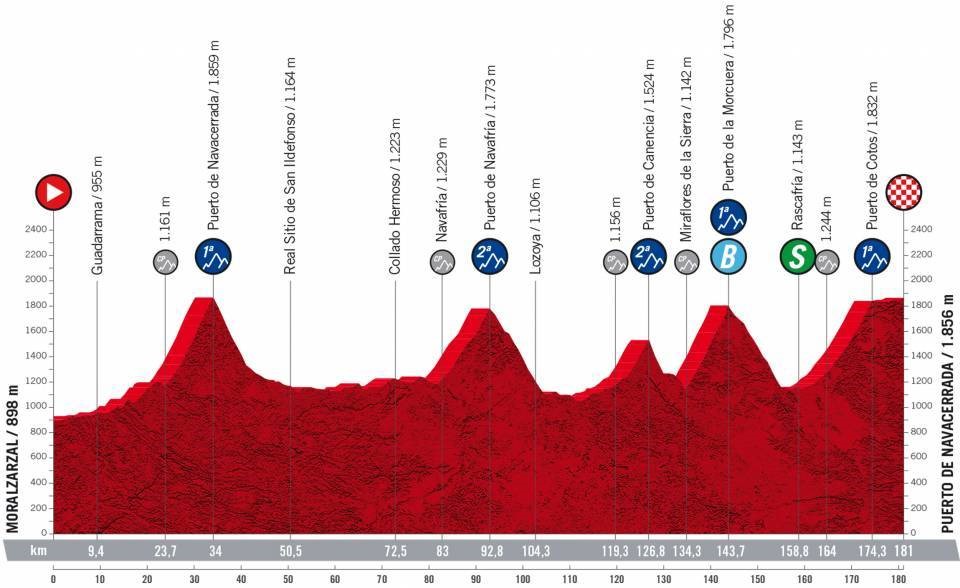
Do not expect the race to be decided by the time we reach Navacerrada. The gaps at the top of the standings will be measured in seconds, not minutes, by this point in proceedings.
If the shark’s teeth set of climbs doesn’t put the fear of God into riders looking at the Stage 20 profile, then the length of it surely will. After almost three weeks of racing, 181km could easily mean five hours in the saddle.
What it will definitely mean, however, is the end of combat operations for another year. At day’s end the positions will be decided and the majority will have no more chances of taking a Grand Tour stage in 2022.
The road rises from km0, which is when, we can say with certainty, the battle for the break will begin. The GC contest will also be somewhat shaped by who makes it, and who doesn’t. Team-mates up the road could be valuable assets for later phases while not having any will put one squad or another on the back foot, even as they’re obliged to take to the front of the peloton.
Isolation will be the name of the game at the start of the stage; it’ll be last man standing by the end.
WHO WILL WIN THE VUELTA 2022?
Primoz Roglic, Enric Mas et Jack Haig sur le podium de la Vuelta 2021
Image credit: Getty Images
Have we got names for you?
The first that should stand out to you from the startlist is that of Monsieur Julian Alaphilippe. We were denied the world champion’s presence at Le Tour due to his horror crash in Liege-Bastogne-Liege.
That can only be the Vuelta’s gain, irrespective of how fully the swashbuckling Frenchman has recovered. Any race in which Alaphilippe is riding is better for it.
And irrespective of what he’s riding for. We’ve been told that he’s only there to hunt stages, and considering how little he’s raced since spring, it would be wise to aim no higher, but there’s no question he’s capable of enduring a GC campaign, if he’s prepared to forego raising his arms aloft a few times.
Regardless, he’s a long way from the front of the favourites pack.
That honour-slash-curse goes to Primoz. Roglic could become only the second four-time winner (after Robert Heras), and the first to achieve the milestone in consecutive editions. No pressure, Primoz.
A close second in line to the Madrid throne has to be Jai Hindley. The Australian rider did not dominate this year’s Giro d’Italia but he was a most worthy winner. He must surely imagine he can stage a repeat in Spain.
After Hindley comes the rider who he roundly defeated, Richard Carapaz. The Olympic champion leads a strong but youthful Ineos Grenadiers squad, one which may not quite have what it takes to support an overall challenge.
‘It’s the Jairo!’ – Redemption for Hindley as Australian makes history
Then we have Simon Yates (BikeExchange-Jayco), who already has one Vuelta to his name, but for whom another probably won’t mean very much, and will rather be the definition of salvaging something from a season.
It would mean more to Ben O’Connor (AG2R Citroen). The Australian succumbed to injuries sustained in a crash on Stage 2 of this year’s Tour de France, having gone in hoping to build on his overall fourth place in the same race in 2021. As long as he is fully healed, and finds his form, there’s no reason to believe he won’t have an impact on the Vuelta.
O’Connor’s countryman Jack Haig (Bahrain Victorious) finds himself in a similar position. His own Tour de France came to an early end on the cobbles. Can he match or improve on his podium place in last year’s race, or will he have to play second maraca to team-mate, Mikel Landa?
Joao Almeida is expected to be UAE Emirates out and out leader, but the Portuguese youngster has yet to prove he can do it on a scorching afternoon in Asturias. Second at the Vuelta a Burgos could be an indication that he’s coming into form, or it might just be his peak.
After that we’re very much into the realm of the numbers-maker-uppers, at least as far as the top 10 is concerned. And yes, that includes Enric Mas (Movistar).
Highlights: Brilliant Evenepoel solos to victory, Alaphilippe in ‘disaster’ crash
Not that the likes of Mike Woods (Israel Premier Tech), Juan Ayuso (UAE Team Emirates), Louis Meintjes (Intermarche Wanty Gobert), Gino Mader (Bahrain Victorious), Tao Geogeghan-Hart (Ineos Grenadiers), Miguel Angel Lopez (Astana) and Hugh Carthy (EF Education First) cannot contribute to the race. And at least one of them will surely exceed our limited expectations. But those expectations are starting low because the rider has either given us no reason to believe, in recent races, that they should be higher, or they are expected to ride in service to a more senior team-mate.
For Vincenzo Nibali (Astana) and Alejandro Valverde (Movistar) it really is the last hurrah. Two long and illustrious Grand Tour careers come to an end on September 11 (and hopefully not before). Expect them both to pick their moment and put on a show.
Lastly, the unanswerable question on everyone’s lips: What will Remco Evenepoel do?
Though the Belgian wunderkind (Quick-Step Alpha Vinyl), who is still only 22, won his first Monument in April, he is still to make it through a three week race.
That the bookies rate him as second favourite for the overall victory should be laughable. But it’s Remco. And, well, you just never know.
– – –
Vuelta a España
Vuelta 2022 route and stages: What’s in store for Roglic and rivals?
YESTERDAY AT 13:23
Vuelta a España
‘We are delighted’ – Roglic passed fit to race at Vuelta just 10 days after returning to training
YESTERDAY AT 15:45
Read the full article Here


